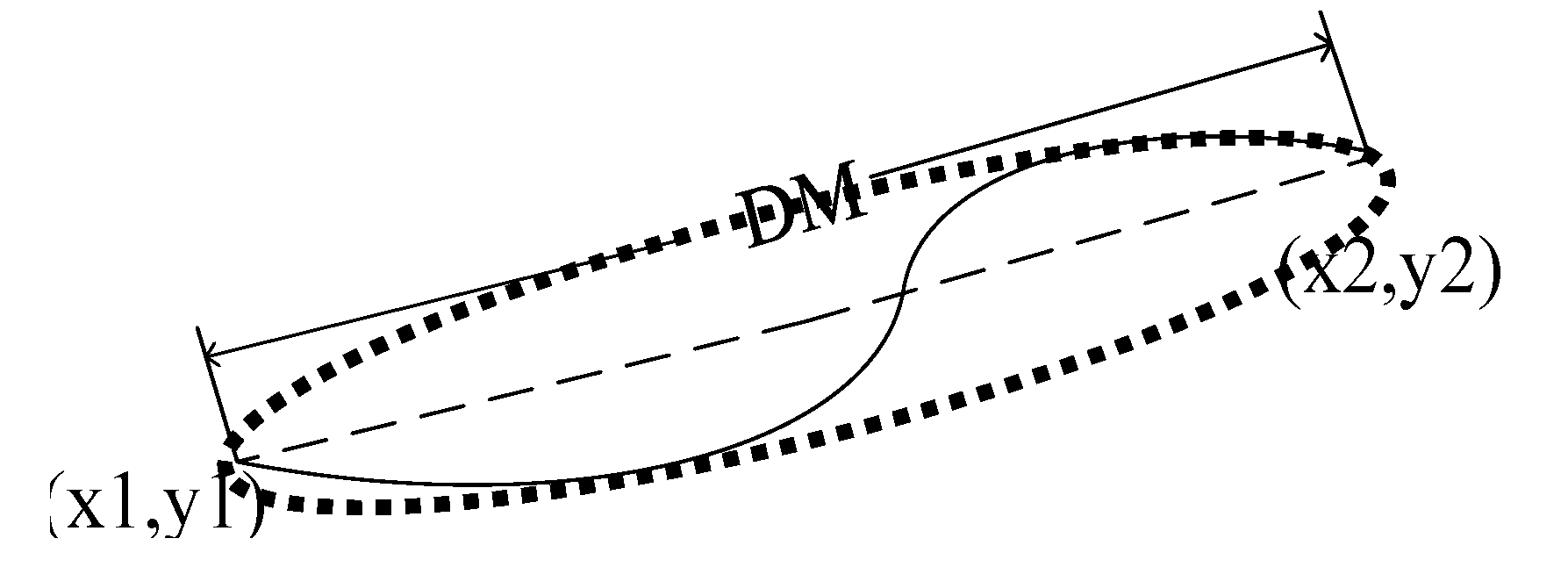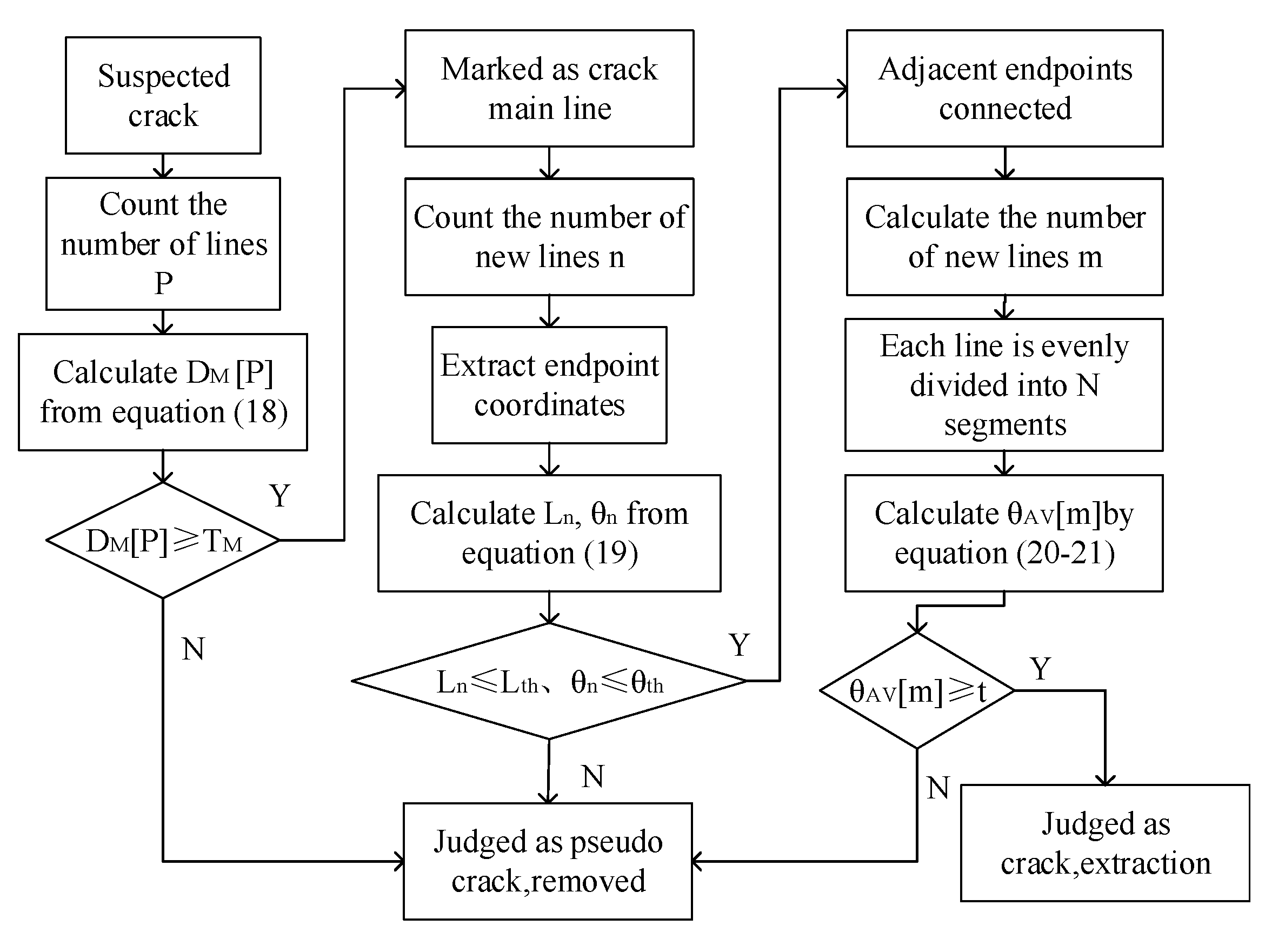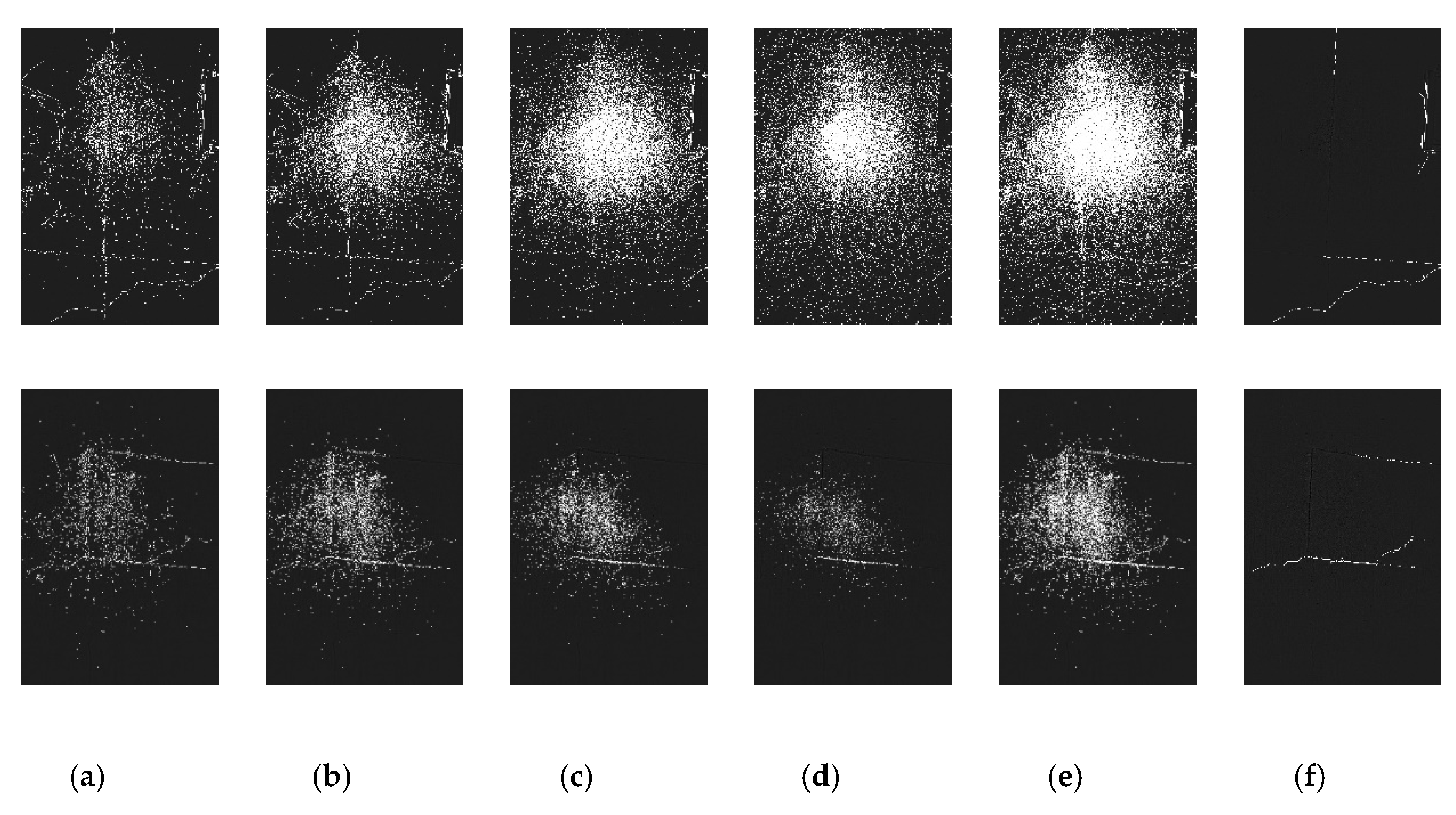Dynamic Partition Gaussian Crack Detection Algorithm Based on Projection Curve Distribution
Abstract
1. Introduction
2. Feature Analysis of Detection Objects
3. Multi-Scale Gaussian Model
3.1. Relationship between Line Width and the Gaussian Model
3.2. Relationship between the Direction and Gradient of the Line and Gaussian Model
4. Proposed Improved Model
4.1. Image Gray Projection Curve
4.2. Dynamic Partition Division Rules
4.3. Multi-Scale Gaussian Crack Detection
5. Crack Extraction
6. Steps of the Proposed Algorithm
| Algorithm 1: DPG algorithm (vertical projection) |
| Input:,,,, |
| Output: suspicious crack lines |
| 1 ; |
| ; |
| 3 for x0 to M |
| 4 |
| 5 |
| 6 if () |
| 7 then; |
| 8 for |
| 9 if (T>) |
| 10 then Marked as suspected crack line 1; |
| 11 end |
| 12 end |
| 13 else if () |
| 14 then; |
| 15 for |
| 16 if (T>) |
| 17 then Marked as suspected crack line 2; |
| 18 end |
| 19 end |
| 20 else |
| ; |
| 22 for |
| 23 if(T>) |
| 24 then Marked as suspected crack line 3; |
| 25 end |
| 26 end |
| 27 end |
| 28 end |
7. Experiment and Discussion
7.1. Database Establishment and Algorithm Testing Platform
7.2. Evaluation Index
7.3. Parameter Selection
7.4. Crack Detection with Different Projection Curves Distributions
7.5. Comparison with Other Methods
8. Conclusions
Author Contributions
Funding
Acknowledgments
Conflicts of Interest
References
- Fisher, W.D.; Camp, T.K.; Krzhizhanovskaya, V.V. Crack Detection in Earth Dam and Levee Passive Seismic Data Using Support Vector Machines. Procedia Comput. Sci. 2016, 80, 577–586. [Google Scholar] [CrossRef]
- Shi, P.; Fan, X.; Ni, J.; Khan, Z.; Li, M. A novel underwater dam crack detection and classification approach based on sonar images. PLoS ONE 2017, 12, e0179627. [Google Scholar] [CrossRef]
- Chen, C.P.; Wang, J.; Zou, L.; Zhang, F.F. Underwater Dam Image Crack Segmentation Based on Mathematical Morpholog. AMM 2012, 220–223, 1315–1319. [Google Scholar] [CrossRef]
- Pan, Y.; Zhang, X.; Sun, M.; Zhao, Q. Object-based and supervised detection of potholes and cracks from the pavement images acquired by UAV. Int. Arch. Photogramm. Remote Sens. Spat. Inf. Sci. 2017, XLII-4/W4, 209–217. [Google Scholar] [CrossRef]
- Ahmed, N.B.C.; Lahouar, S.; Souani, C.; Besbes, K. Automatic crack detection from pavement images using fuzzy thresholding. In Proceedings of the 2017 International Conference on Control, Automation and Diagnosis (ICCAD), Hammamet, Tunisia, 19–21 January 2017; pp. 528–537. [Google Scholar] [CrossRef]
- Mathavan, S.; Vaheesan, K.; Kumar, A.; Chandrakumar, C.; Kamal, K.; Rahman, M.; Stonecliffe-Jones, M. Detection of pavement cracks using tiled fuzzy Hough transform. J. Electron. Imaging 2017, 26, 1. [Google Scholar] [CrossRef]
- Chanda, S.; Bu, G.; Guan, H.; Jo, J.H.; Pal, U.; Loo, Y.-C.; Blumenstein, M. Automatic Bridge Crack Detection—A Texture Analysis-Based Approach. In Advanced Information Systems Engineering; Salinesi, C., Norrie, M.C., Pastor, Ó., Eds.; Springer Berlin Heidelberg: Berlin/Heidelberg, Germany, 2014; Volume 7908, pp. 193–203. [Google Scholar] [CrossRef]
- Li, G.; Zhao, X.; Du, K.; Ru, F.; Zhang, Y. Recognition and evaluation of bridge cracks with modified active contour model and greedy search-based support vector machine. Autom. Constr. 2017, 78, 51–61. [Google Scholar] [CrossRef]
- Yeum, C.M.; Dyke, S.J. Vision-Based Automated Crack Detection for Bridge Inspection: Vision-based automated crack detection for bridge inspection. Comput. Aided Civ. Infrastruct. Eng. 2015, 30, 759–770. [Google Scholar] [CrossRef]
- Porco, F.; Ruggieri, S.; Uva, G. Seismic assessment of irregular existing building: Appraisal of the influence of compressive strength variation by means of nonlinear conventional and multimodal static analysis. Ing. Sismica 2018, 35. [Google Scholar]
- Ruggieri, S.; Porco, F.; Uva, G. A practical approach for estimating the floor deformability in existing RC buildings: Evaluation of the effects in the structural response and seismic fragility. Bull. Earthq. Eng. 2019. [Google Scholar] [CrossRef]
- Yuan, W.Q.; Xue, D.; Group, C.V. Review of tunnel lining crack detection algorithm based on machine vision. Chin. J. Sci. Instrum. 2017, 38, 3100–3111. [Google Scholar]
- Yuan, D.P. Analysis System for Subway Tunnel Image; Beijing Jiaotong University: Beijing, China, 2016. [Google Scholar]
- Bai, B. Research on Crack Identification Algorithm of Subway Tunnel Surface Image; Beijing Jiaotong University: Beijing, China, 2015. [Google Scholar]
- Fujita, Y.; Mitani, Y.; Hamamoto, Y. A Method for Crack Detection on a Concrete Structure. In Proceedings of the 18th International Conference on Pattern Recognition (ICPR’06), Hong Kong, China, 20–24 August 2006; pp. 901–904. [Google Scholar] [CrossRef]
- Chen, W.J. Research on Image Detection Method of Underwater Dam Cracks; North China University of Water Resources and Electric Power: Zhengzhou, China, 2019. [Google Scholar]
- Luo, R. Research of Pavement Crack Detection Algorithm Based on Image Processing; Anhui Polytechnic University: Wuhu, China, 2017. [Google Scholar]
- Liu, L.F.; Wu, Q.S.H.; Yao, B.B. Bridge crack detection based on Gaussian scale space and SVM. Ind. Instrum. Autom. 2019, 13–16, 114. [Google Scholar]
- Yu, S.-N.; Jang, J.-H.; Han, C.-S. Auto inspection system using a mobile robot for detecting concrete cracks in a tunnel. Autom. Constr. 2007, 16, 255–261. [Google Scholar] [CrossRef]
- Wang, S.F.; Che, Y.L.; Li, N.; Xu, Z.H.G.; An, Y.S.H. Asphalt Pavement Crack Detection Algorithm Based on Multi-scale Ridges. China J. Highw. Transp. 2017, 30, 32–41. [Google Scholar]
- Lu, Z.W.; Wu, C.H.D.; Chen, D.Y.; Shang, S.H.B. Pavement Crack Detection Algorithm Based on Sub-region and Multi-scale Analysis. J. Northeast. Univ. (Nat. Sci.) 2014, 35, 622–625. [Google Scholar]
- Zhou, L.J.; Liu, X. Low-contrast Crack Detection Method Based on Fractional Fourier Transform. Comput. Sci. 2019, 46, 208–210. [Google Scholar]
- Wang, P.R.; Huang, H.W.; Xue, Y.D. Automatic recognition of cracks in tunnel lining based on characteristics of local grids in images. Chin. J. Rock Mech. Eng. 2012, 31, 991–999. [Google Scholar]
- Ai, D.; Jiang, G.; Kei, L.S.; Li, C. Automatic Pixel-Level Pavement Crack Detection Using Information of Multi-Scale Neighborhoods. IEEE Access 2018, 6, 24452–24463. [Google Scholar] [CrossRef]
- Huang, H.; Li, Q.; Zhang, D. Deep learning based image recognition for crack and leakage defects of metro shield tunnel. Tunn. Undergr. Space Technol. 2018, 77, 166–176. [Google Scholar] [CrossRef]
- Protopapadakis, E.; Stentoumis, C.; Doulamis, N.; Loupos, K.; Makantasis, K.; Kopsiaftis, G.; Amditis, A. Autonomous robotic inspection in tunnels. ISPRS Ann. Photogramm. Remote Sens. Spat. Inf. Sci. 2016, III–5, 167–174. [Google Scholar] [CrossRef]
- Fei, Y.; Wang, K.C.P.; Zhang, A.; Chen, C.; Li, Q.J.; Liu, Y.; Yang, G.; Li, B. Pixel-Level Cracking Detection on 3D Asphalt Pavement Images Through Deep-Learning- Based CrackNet-V. IEEE Trans. Intell. Transport. Syst. 2020, 21, 273–284. [Google Scholar] [CrossRef]
- Steger, C. An unbiased detector of curvilinear structures. IEEE Trans. Pattern Anal. Machine Intell. 1998, 20, 113–125. [Google Scholar] [CrossRef]












| Type | w(pixels) | σ |
|---|---|---|
| Concrete potholes | < 5 | < 1.45 |
| Cracks | 5–15 | 1.45–4.33 |
| Other pseudo cracks | ≥ 10 | ≥ 2.89 |
| Algorithm | Recall after Detection | Precision after Detection | Recall after the Crack Screening | Precision after the Crack Screening |
|---|---|---|---|---|
| [18] | 94.2% | 2% | 39% | 50.2% |
| In this paper | 96.4% | 2.3% | 40% | 78.8% |
© 2020 by the authors. Licensee MDPI, Basel, Switzerland. This article is an open access article distributed under the terms and conditions of the Creative Commons Attribution (CC BY) license (http://creativecommons.org/licenses/by/4.0/).
Share and Cite
Xue, D.; Yuan, W. Dynamic Partition Gaussian Crack Detection Algorithm Based on Projection Curve Distribution. Sensors 2020, 20, 3973. https://doi.org/10.3390/s20143973
Xue D, Yuan W. Dynamic Partition Gaussian Crack Detection Algorithm Based on Projection Curve Distribution. Sensors. 2020; 20(14):3973. https://doi.org/10.3390/s20143973
Chicago/Turabian StyleXue, Dan, and Weiqi Yuan. 2020. "Dynamic Partition Gaussian Crack Detection Algorithm Based on Projection Curve Distribution" Sensors 20, no. 14: 3973. https://doi.org/10.3390/s20143973
APA StyleXue, D., & Yuan, W. (2020). Dynamic Partition Gaussian Crack Detection Algorithm Based on Projection Curve Distribution. Sensors, 20(14), 3973. https://doi.org/10.3390/s20143973




